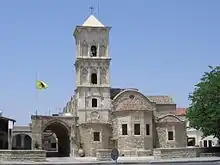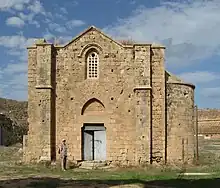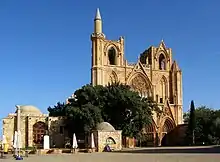Religion in Cyprus
Religion in Cyprus is dominated by Eastern Orthodox branch of Christianity, whose adherents make up 73% of the total population of the entire island. Most Greek Cypriots are members of the autocephalous Greek Orthodox 'Church of Cyprus'. Most Turkish Cypriots are officially Sunni Muslims. There are also Baháʼí, Catholic, Jewish, Protestant (including Anglican), Maronite, Armenian Apostolic, and non-religious communities in Cyprus.
Religion in government-controlled area of Cyprus, 2011 Census[1]
Religion in the entire island of Cyprus (including Northern Cyprus), 2010[2]
Christianity
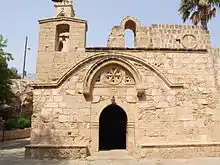
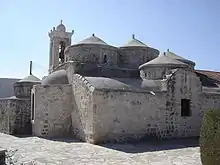
Greek Orthodox Church of Cyprus
The largest and most important church in Cyprus, the Church of Cyprus, is an autocephalous Greek Orthodox Church within the Orthodox tradition using the Greek liturgy.[3] It is one of the oldest Eastern Orthodox autocephalous churches, achieving independence from the Patriarchate of Antioch and All the East in 431 A.D.[4] The bishop of the ancient capital, constituted metropolitan by Emperor Zeno, with the title archbishop. The first Bishops that held Christian ministries in Cyprus were Apostle Lazarus (Church of Saint Lazarus, Larnaca), and Apostle Barnabas (Barnabas) (who was originally from Cyprus[5]) and the island became the destination for many of the first Christians after the resurrection of Christ.[6]
The Church of Cyprus recognizes the seniority and prestige of the ecumenical patriarch in Constantinople, while retaining complete administrative autonomy under its own archbishop.[3] Seven sacraments are recognized: baptism in infancy, followed by confirmation with consecrated oil, penance, the Eucharist, matrimony, ordination, and unction in times of sickness or when near death.[3]
Many Classical Christian architecture and buildings are located in Cyprus; along with the former tomb of Apostle Lazarus and tomb of Apostle Barnabas. Cyprus is the place where many New Testament biblical stories took place, Christian miracles were performed and where the Apostles established their first churches.
Armenian Church in Cyprus
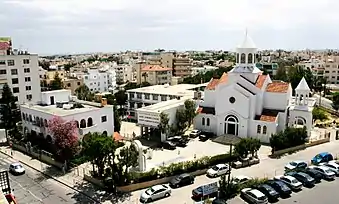
The presence of Armenians in Cyprus dates back to 578. Currently, Armenian-Cypriots maintain a notable presence of about 3,500 persons, mainly inhabiting the urban areas of Nicosia, Larnaca, and Limassol. Recently, some Armenian immigrants have settled Paphos.
The Armenian Prelature of Cyprus has had a continuous presence on the island since its establishment in 973 by Catholicos Khatchig I.
Catholic Church
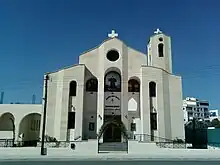
The Catholic Church in Cyprus is part of the worldwide Catholic Church under the spiritual leadership of the Pope in Rome. According to the 2011 census, Catholics made up 2.9% of the population.[7] Most Catholics in Cyprus are Maronites (one of the Eastern Rite Catholics). In the 1891 census, of the 209,286 Cypriots, there were 1,131 were Maronites.
Protestantism
After the arrival of the British,[8] The Anglican Church of Cyprus was established in 1878. As of 1976, it falls under the Diocese of Cyprus and the Gulf. With regard to Northern Cyprus, Anglican Church of Cyprus was established in 1878.
The community numbered around 500 people in 2009, and could be found living throughout northern Cyprus.[9] According to the 2011 census, Protestants made up 2% of the population.[7]
Islam
Muslims make up about 1.8% of the population of the government-controlled areas of the Republic of Cyprus and around 25% of the population of the entire island, including the illegally occupied areas in the northern part of the country. The island was conquered by the Ottoman General Lala Mustafa Pasha from the Venetians in 1570 A.D. This conquest brought with it Turkish settlement from 1571 to 1878 A.D. for administrative duties, military fortifications, and tax collection. Turkish Cypriots adhere to the Sunni branch of Islam.
Sufism also plays an important role. Historically, Muslims were spread over the whole of Cyprus, but since 1974 they have lived primarily in the north after the Turkish invasion. The Ahmadiyya community has a presence in the north.[10]
Several important Islamic shrines and landmarks exist on the island, including:
- The Arabahmet Mosque in Nicosia (built in the 16th century)
- The Hala Sultan Tekke/Umm Haram Mosque in Larnaca (built in the 18th century)
Buddhism
According to the 2011 census, Buddhists made up about 1% of the population.[7]
Judaism
Jewish presence in Cyprus dates back to the 3rd century BC, after settling on the island, they established trade relations with other religious groups.[14] In 2022, there were approximately 6,000 Jewish people on the island,[7] who wre either permanent residents or citizens in Cyprus. There are active Synagogues in Larnaca, Limassol, Nicosia, Paphos and Ayia Napa with dedicated Rabbis to each.
All religious matters are handled by the Chief Rabbinate of Cyprus, headed by Chief Rabbi Arie Zeev Raskin.
Atheism
According to a 2011 estimate, in the Greek-Cypriot government-controlled area, 0.6% of the people consider themselves irreligious or atheist.[15] In 2018, the Cyprus Humanist Association accused Cyprus' Ministry of Education of discrimination against atheists by promoting anti-atheist educational material through its official website.[16] During the 37th session of the United Nations Human Rights Council, the International Humanist Union listed Cyprus in their list of states accused of promoting hatred against atheists and humanists.[17]
Freedom of religion
In 2023, the country was scored 4 out of 4 for religious freedom.[18]
See also
References
- "Population census of Cyprus". Statistical Service of Cyprus. Retrieved 28 August 2017.
- Pew Research Center's Religion & Public Life Project: Cyprus. Pew Research Center. 2010.
- Meleagrou, Eleni; Birol, Yesilada (1993). "Religion". In Solsten, Eric (ed.). Cyprus: a country study (4th ed.). Washington, D.C.: Federal Research Division, Library of Congress. pp. 70, 72. ISBN 0-8444-0752-6. OCLC 27014039.
 This article incorporates text from this source, which is in the public domain.
This article incorporates text from this source, which is in the public domain.{{cite encyclopedia}}: CS1 maint: postscript (link) - World Council of Churches website, Church of Cyprus page
- Bible Gateway website, Acts 4:36, Joseph, a Levite from Cyprus, whom the apostles called Barnabas (which means “son of encouragement”)
- Bible Gateway website, Acts 11:19, Now those who had been scattered by the persecution that broke out when Stephen was killed traveled as far as Phoenicia, Cyprus and Antioch
- US State Dept 2022 report on the Republic of Cyprus
- Melton, J. Gordon; Baumann, Martin (21 September 2010). Religions of the World: A Comprehensive Encyclopedia of Beliefs and Practices, 2nd Edition [6 volumes]. ABC-CLIO. p. 843. ISBN 978-1-59884-204-3.
- "Cyprus PIO: Turkish Press and Other Media, 09-08-05".
- "Members Of The Ahmadiyya Muslim Community Dr Muhammed Jalal Shams, Osman Seker, Kubilay Çil: Prisoners of conscience for their religious beliefs". Amnesty International. June 5, 2002. Retrieved June 10, 2014.
- Religious freedom report. Cyprus
- "National Profiles".
- "Cyprus, Religion And Social Profile". thearda.com.
- "Cyprus: Virtual Jewish History Tour". Jewish Virtual Library. Retrieved February 21, 2013.
- "Middle East :: CYPRUS". CIA The World Factbook. 20 October 2021.
- Evie Andreou (13 January 2018). "Humanists slam education ministry's anti-atheist teaching materials". Cyprus Mail. Retrieved 23 April 2018.
- Elizabeth O'Casey (2018-03-09). "Actually, 'freedom from religion' is a human right, IHEU tells Vatican at the UN". Retrieved 23 April 2018.
- Freedom House website, retrieved 2023-08-08
